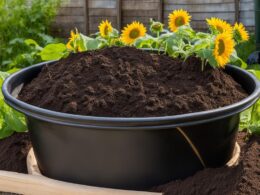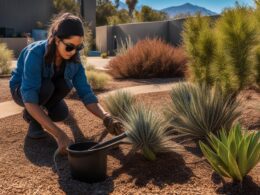Drought conditions can pose challenges for gardeners, especially when it comes to growing edible plants. However, with the right plants and waterwise gardening practices, you can still enjoy a bountiful harvest. In this guide, we will explore the top 10 drought-tolerant edible plants and provide tips on how to grow them in a drought-prone climate.
Key Takeaways:
- Despite drought conditions, it is possible to grow edible plants in your garden.
- By choosing drought-tolerant plants and implementing waterwise gardening practices, you can save water and garden sustainably.
- Waterwise gardening techniques include deep watering, mulching, and watering in the early morning.
- There are many drought-tolerant edible plants and fruit trees that can thrive in dry conditions.
- Consider exploring native plants and expanding your culinary horizons in your garden.
Can You Grow Edible Plants in a Drought?
Despite the challenges of a drought, you can still grow edible plants in your garden. While your harvest may be different than what you’re used to, there are plenty of drought-tolerant options available. By choosing plants that are adapted to dry conditions and implementing waterwise gardening practices, you can successfully grow edible plants even in a drought.
When it comes to selecting drought-tolerant edible plants, it’s important to consider their ability to withstand long periods without ample water. Look for plants with deep root systems that can access moisture deeper in the soil. Succulents, such as agave and prickly pear cactus, are excellent choices for dry climates. They store water in their leaves, allowing them to thrive in arid conditions.
In addition to choosing the right plants, practicing waterwise gardening techniques can help conserve precious water resources. Mulching around your plants can help retain moisture and prevent evaporation, while drip irrigation systems deliver water directly to the roots, minimizing waste. It’s also advisable to water your plants in the early morning when temperatures are cooler, reducing water loss due to evaporation.
“Even during a drought, you can enjoy the benefits of a fruitful garden by selecting the right plants and implementing waterwise practices.”
Remember that during a drought, it’s essential to prioritize water usage. Focus your watering efforts on critical stages of plant growth, such as transplanting and fruit forming periods. This will ensure that your plants receive the necessary moisture when they need it most.
Benefits of Growing Drought-Tolerant Edible Plants
Growing drought-tolerant edible plants offers several benefits. Firstly, it allows you to maintain a sustainable garden by conserving water. By selecting plants that can thrive in dry conditions, you can reduce your water consumption and contribute to water conservation efforts.
Secondly, growing drought-tolerant edible plants provides you with a sense of self-sufficiency. You can still enjoy fresh, homegrown produce even in drought-prone areas. Plus, many drought-tolerant plants are packed with flavor and nutritional value, making them a fantastic addition to your meals.
Lastly, cultivating a garden of drought-tolerant edible plants can inspire others in your community. By showcasing how it’s possible to grow food sustainably even in challenging conditions, you can encourage others to adopt waterwise gardening practices and promote environmental stewardship.
Tips for Growing Food in a Drought
Growing food in a drought requires some adjustments to your gardening routine, but with the right strategies, you can still have a productive harvest. Implementing waterwise gardening practices is key to maximizing your limited water resources and ensuring the survival of your edible plants. Here are some tips to help you succeed:
1. Deep Watering
- Water deeply and infrequently to encourage deep root growth. This helps plants become more resilient to drought conditions.
- Focus on delivering water directly to the roots rather than watering the entire garden bed.
- Consider using drip irrigation or soaker hoses to provide targeted watering.
2. Mulching
- Apply a layer of mulch around your plants to help conserve moisture in the soil.
- Mulch acts as a barrier, reducing evaporation and suppressing weed growth.
- Choose organic mulch materials like straw, wood chips, or compost.
3. Watering Times
- Water your plants early in the morning or late in the evening to minimize evaporation.
- Avoid watering during the hottest part of the day to prevent water loss through evaporation and to protect plants from heat stress.
4. Transplanting and Fruit Formation
- When transplanting seedlings, water thoroughly to help establish their root systems in the new location.
- During fruit formation, prioritize watering to ensure proper development and prevent dry, cracked fruits.
- Monitor your plants closely during these critical periods and adjust watering accordingly.
By following these tips, you can make the most of your limited water resources while growing food in a drought. Remember to choose drought-tolerant plants and adapt your gardening practices to suit dry conditions. With a little extra care and attention, you can still enjoy a thriving garden and a bountiful harvest.
Top 10 Drought-Tolerant Edible Plants
When it comes to growing edible plants in a drought-prone climate, choosing the right drought-tolerant varieties is key. These plants have adapted to survive and thrive with less water, making them perfect for waterwise gardening. Here are the top 10 drought-tolerant edible plants that you can grow with ease:
- 1. Lavender – Known for its fragrant blooms and versatile use in cooking, lavender is a beautiful addition to any garden. It requires well-drained soil and minimal watering once established.
- 2. Rosemary – This popular herb is not only drought-tolerant but also adds a flavorful punch to your dishes. Rosemary prefers full sun and well-drained soil.
- 3. Kale – A nutritious leafy green, kale is known for its ability to withstand various weather conditions, including drought. It grows well in containers or garden beds.
- 4. Cactus fruit – Cactus fruit, also known as prickly pear or tunas, is not only drought-tolerant but also rich in antioxidants and vitamins. It thrives in arid regions with well-drained soil.
- 5. Thyme – This aromatic herb is not only drought-tolerant but also adds a savory flavor to your dishes. Thyme prefers full sun and well-drained soil.
- 6. Sage – With its distinct flavor and grayish-green leaves, sage is a popular herb for culinary use. It requires minimal watering and thrives in well-drained soil.
- 7. Cherry tomatoes – These bite-sized tomatoes are not only delicious but also perfect for growing in a drought. They can be grown in containers or garden beds.
- 8. Artichokes – Known for their unique appearance and delicious taste, artichokes are drought-tolerant plants that thrive in well-drained soil.
- 9. Garlic – This pungent bulb is not only a staple in many cuisines but also a hardy plant that can withstand drought conditions.
- 10. Fig trees – These fruit trees are well-suited for dry climates and require minimal watering once established. They produce delicious, sweet figs that can be enjoyed fresh or used in a variety of recipes.
By incorporating these drought-tolerant edible plants into your garden, you can enjoy a bountiful harvest while conserving water. Remember to provide proper care and maintenance, such as regular pruning and fertilizing, to ensure the health and productivity of your plants. Happy gardening!
Drought-Tolerant Fruit Trees
If you’re looking to add some fruit trees to your drought-tolerant garden, you’re in luck. There are several varieties that can thrive in dry conditions, requiring less water compared to other fruit trees. These drought-tolerant fruit trees not only provide delicious and nutritious fruits but also add beauty and shade to your garden.
One of the top choices for a drought-tolerant fruit tree is the pomegranate. Pomegranates are known for their vibrant red fruits and can withstand long periods of drought once established. They are also relatively low-maintenance, making them an excellent option for a waterwise garden. Plus, pomegranates are rich in antioxidants and have numerous health benefits.
Another great choice is the fig tree. Figs are incredibly resilient and can tolerate drought conditions without compromising their fruit production. They have a unique and sweet flavor, making them a favorite among many gardeners. Fig trees also have a beautiful and distinctive shape, adding an aesthetic appeal to your garden.
Lastly, consider planting a citrus tree, such as a lemon or lime tree. Citrus trees are well-suited to drought conditions and can thrive with minimal water. They provide an abundance of juicy and aromatic fruits, perfect for adding zest to your culinary creations. Citrus trees also have glossy green foliage, adding a touch of vibrancy to your garden.
| Fruit Tree | Drought Tolerance | Fruit Description |
|---|---|---|
| Pomegranate | High | Red, antioxidant-rich fruits |
| Fig | High | Sweet and unique-flavored fruits |
| Citrus (lemon, lime) | High | Juicy and aromatic fruits |
With these drought-tolerant fruit trees in your garden, you can enjoy a plentiful harvest while conserving water. Remember to provide proper care and maintenance, including regular pruning and feeding, to ensure the health and productivity of your fruit trees. Happy gardening!
Drought-Tolerant Edible Plants
When it comes to cultivating a garden in a drought-prone climate, it’s important to choose plants that can thrive with minimal water. In addition to fruit trees and herbs, there are several other drought-tolerant edible plants that you can incorporate into your garden. These plants can not only survive in dry conditions but also provide you with a variety of tasty and nutritious harvests.
1. Swiss Chard: This leafy green is not only drought-tolerant but also packed with vitamins and minerals. It can be grown from early spring to late fall and comes in a variety of vibrant colors. Swiss chard is versatile in the kitchen and can be sautéed, steamed, or used in salads.
2. Cacti: Cacti are well-known for their ability to thrive in arid environments. Some cacti species produce edible fruits, such as prickly pear cactus and dragon fruit. These fruits are not only delicious but also rich in antioxidants and fiber.
3. Lavender: Known for its beautiful purple flowers and soothing fragrance, lavender is also a drought-tolerant herb with culinary uses. Its flowers can be used in baking, teas, or as a garnish. Additionally, lavender has calming properties and can be used to make essential oils or natural remedies.
4. Rosemary: A popular herb in Mediterranean cuisine, rosemary is well-suited for dry climates. This aromatic herb can be used to flavor various dishes, such as roasted vegetables, grilled meats, and homemade bread. It’s also known for its potential health benefits, including improved digestion and memory.
Tips for Growing Drought-Tolerant Edible Plants
When growing drought-tolerant edible plants, there are a few tips that can help ensure their success:
- Choose the right location: Select a spot in your garden that receives full sun and has well-draining soil.
- Water deeply but infrequently: Rather than watering your plants frequently, it’s better to provide them with deep, thorough watering less frequently. This encourages their roots to grow deeper and become more drought-resistant.
- Add organic mulch: Mulching around your plants helps to retain moisture in the soil and suppress weeds.
- Harvest regularly: Regularly harvesting your edible plants encourages new growth and helps them maintain their productivity.
With the right selection of drought-tolerant edible plants and proper care, you can enjoy a thriving garden even in the face of water scarcity. Not only will you be able to savor the flavors of your homegrown harvest, but you’ll also contribute to a more sustainable and water-wise future.
Drought-Tolerant Herbs
When it comes to growing drought-tolerant edible plants, herbs are an excellent choice. Not only do they add flavor to your dishes, but they also require less water compared to other plants. Here are three drought-tolerant herbs that you can easily grow in your garden:
- Rosemary: Known for its savory aroma and versatile uses in the kitchen, rosemary is a hardy herb that can withstand dry conditions. It thrives in well-drained soil and prefers full sun. With its drought-tolerant nature, rosemary is a great addition to any waterwise garden.
- Thyme: Another herb that can thrive in dry conditions is thyme. Whether it’s used in soups, stews, or roasted dishes, thyme adds a delightful flavor to your culinary creations. It grows well in sandy soil and requires minimal watering once established.
- Lavender: Known for its beautiful flowers and soothing scent, lavender is not only a drought-tolerant herb but also a great addition to any garden. It thrives in well-drained soil and prefers full sun. Harvest the flowers to make herbal tea or use them in baking for a touch of floral flavor.
These drought-tolerant herbs not only add flavor to your meals but also provide a beautiful addition to your garden. With their ability to withstand dry conditions, they are a sustainable choice for any gardener.
Table: Comparison of Drought-Tolerant Herbs
| Herb | Growing Conditions | Watering Needs | Uses |
|---|---|---|---|
| Rosemary | Well-drained soil, full sun | Minimal watering once established | Culinary uses, herbal teas |
| Thyme | Sandy soil, full sun | Minimal watering once established | Culinary uses, aroma therapy |
| Lavender | Well-drained soil, full sun | Minimal watering once established | Culinary uses, herbal teas, floral arrangements |
As you can see from the table above, these drought-tolerant herbs have different growing conditions and uses. However, they all have one thing in common – they are well-suited for dry climates and require minimal watering once established. By incorporating these herbs into your garden, you can enjoy their flavors and fragrances while conserving water.
So why not add some drought-tolerant herbs to your garden? Not only will they enhance your culinary creations, but they will also contribute to a sustainable and waterwise garden. With their resilience in dry conditions, these herbs are the perfect choice for any herb lover or aspiring gardener.
Native Plants as Drought-Tolerant Edibles
Native plants are a great choice for your drought-tolerant edible garden. They are adapted to the specific environmental conditions of your region, making them more likely to thrive with minimal water. These plants have evolved over time to survive in your local climate, requiring less maintenance and reducing the need for excessive watering.
When selecting native plants for your garden, consider those that have edible parts. Many native plants provide not only aesthetic beauty but also a variety of flavors and culinary uses. Incorporating these plants into your garden can add a unique touch to your dishes while supporting local biodiversity.
Here are a few native plants that are attractive, tasty, and easy to grow:
| Native Plant | Culinary Uses |
|---|---|
| Prickly Pear Cactus | The young pads (nopales) can be cooked and used in various dishes, or the fruits (tunas) can be eaten raw or made into jams and jellies. |
| Yucca | The flowers, fruit, and young shoots of yucca plants are all edible. The flowers can be used in salads, while the fruit and shoots can be cooked and used in a variety of dishes. |
| Chiltepin Pepper | The small, fiery chiltepin peppers are commonly used in traditional Mexican cuisine, adding a spicy kick to salsas, stews, and sauces. |
By incorporating these native plants into your drought-tolerant edible garden, you can create a sustainable and unique culinary experience while conserving water and supporting local ecosystems.
Expand Your Culinary Horizons
Don’t limit your garden to just the familiar fruits and vegetables. There are countless edible plants waiting to be discovered. By exploring new culinary horizons, you can add unique flavors and textures to your meals. Let’s take a look at some additional edible plants that can elevate your cooking.
Exotic Herbs:
Expand your herb collection with some exotic varieties that are not commonly found in traditional gardens. Try growing lemongrass, which adds a refreshing citrusy flavor to dishes and is commonly used in Southeast Asian cuisine. Another exotic herb to consider is za’atar, a Middle Eastern herb blend that combines flavors of thyme, oregano, sesame seeds, and sumac. Adding these unique herbs to your culinary repertoire can take your dishes to a whole new level.
Unusual Vegetables:
Step out of your comfort zone and grow some unusual vegetables that are not commonly found in grocery stores. Consider planting purple carrots, which add a pop of color to your meals and have a slightly sweeter taste than their orange counterparts. You can also try growing kohlrabi, a versatile vegetable with a mild and crunchy flavor. Experimenting with these unusual vegetables can bring excitement and variety to your everyday meals.
Forgotten Fruits:
Discover forgotten fruits that are not commonly found in mainstream supermarkets but offer delicious flavors. One such fruit is the jujube, also known as the Chinese date. Jujubes have a sweet and tangy taste and are often used in desserts or enjoyed fresh. Another lesser-known fruit to consider is the pawpaw, a tropical-flavored fruit that tastes like a cross between a banana and a mango. By incorporating these forgotten fruits into your recipes, you can create unique and memorable dishes.
| Edible Plant | Culinary Use | Flavor Profile |
|---|---|---|
| Lemongrass | Used in curries, soups, and stir-fries | Refreshing, citrusy |
| Za’atar | Used as a spice blend on roasted vegetables, bread, and meat | Herbaceous, tangy, nutty |
| Purple Carrots | Roasted, stir-fried, or used in salads | Slightly sweet, earthy |
| Kohlrabi | Raw in salads, roasted, or used in soups and stews | Mild, crunchy |
| Jujube | Eaten fresh, dried, or used in desserts | Sweet, tangy |
| Pawpaw | Eaten fresh, used in smoothies, or incorporated into baked goods | Tropical, banana-mango flavor |
By expanding your culinary horizons and experimenting with new edible plants, you can add excitement and diversity to your meals. Whether it’s incorporating exotic herbs, trying unusual vegetables, or discovering forgotten fruits, there are endless possibilities for creating delicious and unique dishes.
Additional Resources for Drought-Tolerant and Edible Gardening
If you want to further explore the world of drought-tolerant and edible gardening, there are several resources available to help you enhance your knowledge and create a thriving, sustainable garden.
Workshops and Tastings at Rancho Santa Ana Botanic Garden
A great resource for learning more about native plants and their culinary uses is the Rancho Santa Ana Botanic Garden. They offer workshops and tastings that provide valuable insights into drought-tolerant gardening and the diverse range of edible plants that can thrive in dry conditions. These events allow you to connect with experts in the field and gain hands-on experience in growing and using drought-tolerant plants in your garden. It’s an opportunity to learn from experienced gardeners and expand your understanding of sustainable gardening practices.
Grow Native Nursery
Another valuable resource available at Rancho Santa Ana Botanic Garden is their Grow Native Nursery. Here, you can find and purchase a variety of drought-tolerant plants mentioned in this guide. The nursery offers a wide selection of native plants, including fruit trees, herbs, and other edible plants. By purchasing plants from a reputable source like the Grow Native Nursery, you can ensure that you are getting high-quality, locally adapted plants that are well-suited to your drought-prone climate.
Online Communities and Forums
Connecting with like-minded individuals who share your interest in drought-tolerant and edible gardening can be a great way to expand your knowledge and exchange ideas. There are numerous online communities and forums dedicated to sustainable gardening practices, where you can ask questions, share experiences, and learn from others who have already mastered the art of growing edible plants in a drought. These platforms provide a supportive environment for gardening enthusiasts to connect and learn from one another, creating a sense of community and fostering a love for sustainable gardening.
By utilizing these resources, you can gain valuable insights and practical tips that will help you succeed in your drought-tolerant and edible gardening endeavors. Whether you choose to attend workshops, visit the Grow Native Nursery, or engage with online communities, you’ll be equipped with the knowledge and tools to create a thriving, sustainable garden filled with delicious and drought-tolerant edible plants.
Conclusion
Growing drought-tolerant edible plants is a sustainable choice for your garden. By choosing plants adapted to dry conditions and implementing waterwise gardening practices, you can save water, reduce environmental impact, and still enjoy a bountiful harvest.
Whether you prefer fruit trees, herbs, or native plants, there are plenty of options to choose from. These drought-tolerant edible plants can thrive in gardens even during droughts, making them a reliable source of fresh food.
Embracing sustainable gardening practices not only helps conserve water but also promotes the health of your garden and the environment. By growing drought-tolerant edible plants, you can contribute to the overall sustainability of your garden and create a more resilient ecosystem.
So, start growing your own drought-tolerant edible garden today and experience the joy of sustainable gardening while enjoying the delicious rewards of your efforts.
FAQ
Can edible plants be grown in a drought?
Yes, it is possible to grow edible plants in a drought by choosing drought-tolerant varieties and implementing waterwise gardening practices.
What are some tips for growing food in a drought?
Some tips for growing food in a drought include deep watering, mulching, watering in the early morning, and paying attention to critical watering periods.
What are the top 10 drought-tolerant edible plants?
The top 10 drought-tolerant edible plants include fruit trees, peppers, tomatoes, beans, kale, chard, rosemary, oregano, California poppy, and prickly pear cactus.
What are some drought-tolerant fruit trees?
Some drought-tolerant fruit trees include pomegranate, fig, and olive trees.
What are some other drought-tolerant edible plants?
Other drought-tolerant edible plants include peppers, tomatoes, beans, kale, chard, rosemary, oregano, California poppy, and prickly pear cactus.
What are some drought-tolerant herbs?
Some drought-tolerant herbs include rosemary, oregano, and thyme.
What are some native plants that are drought-tolerant and edible?
Some native plants that are drought-tolerant and edible include manzanita, toyon, and miner’s lettuce.
What are some unique edible plants to consider?
Some unique edible plants to consider include edible flowers like nasturtium and violets, as well as unusual fruits like jujubes and pineapple guava.
Where can I find additional resources for drought-tolerant and edible gardening?
Additional resources for drought-tolerant and edible gardening can be found at the Rancho Santa Ana Botanic Garden, which offers workshops, tastings, and a Grow Native Nursery.














